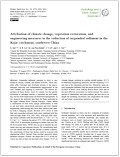| Journal Article |
 |
|
| Article Title | Attribution of climate change, vegetation restoration, and engineering measures to the reduction of suspended sediment in the Kejie catchment, southwest China | | Author | Xing Ma, X.X. Lu, Meine van Noordwijk, J. T. Li and Xu Jianchu | | Year | 2014 | | Journal Title | Hydrology and Earth System Sciences | | Institution | European Geosciences Union | | Volume | 18 | | Pages | 1979-1994 | | Call Number | JA0578-14 |
|
| Abstract: |
| Suspended sediment transport in rivers is controlled
by terrain, climate, and human activities. These variables
affect hillslope and riverbank erosion at the source,
transport velocities and sedimentation opportunities in the
river channel, and trapping in reservoirs. The relative importance
of those factors varies by context, but the specific
attribution to sediment transfer is important for policymaking,
and has wide implications on watershed management. In
our research, we analyzed data from the Kejie watershed in
the upper Salween River (Yunnan Province, China), where
a combination of land cover change (reforestation, as well
as soil and water conservation measures) and river channel
engineering (sand mining and check dam construction) interact
with a changing climate. Records (1971–2010) of river
flow and suspended sediment loads were combined with five
land-use maps from 1974, 1991, 2001, 2006 and 2009. Average
annual sediment yield decreased from 13.7 t ha?1 yr?1 to
8.3 t ha?1 yr?1 between the period 1971–1985 and the period
1986–2010. A distributed hydrological model (Soil and Water
Assessment Tools, SWAT) was set up to simulate the sediment
sourcing and transport process. By recombining landuse
and climate data for the two periods in model scenarios,
the contribution of these two factors could be assessed with
engineering effects derived from residual measured minus
modeled transport. Overall, we found that 47.8% of the decrease
was due to land-use and land cover change, 19.8% to
climate change, resulting in a milder rainfall regime, 26.1%
to watershed engineering measures, and the remaining 6.3%
was due to the simulation percent bias. Moreover, mean annual
suspended sediment yield decreased drastically with the
increase of forest cover, making diverse forest cover one of
the most effective ecosystems to control erosion. For consideration
of stakeholders and policymakers, we also discuss at
length the modeling uncertainty and implications for future
soil and water conservation initiatives in China. |
|